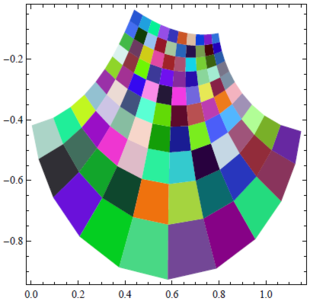|
|
| Line 45: |
Line 45: |
|
|} |
|
|} |
|
|
|
|
|
We verify that <math>S</math> satisfies (1) and (2). By the addition and multiplication tables, <math>S</math> is closed under addition and scalar multiplication. Since <math>a + b = b + a = b</math> and <math>ab = ba = a</math>, then <math>S</math> is commutative. By extension, <math>S</math> is also associative. |
|
We verify that <math>S</math> satisfies (1). By the addition and multiplication tables, <math>S</math> is closed under addition and scalar multiplication. Since <math>a + b = b + a = b</math> and <math>ab = ba = a</math>, then <math>S</math> is commutative. It can also be shown that <math>S</math> is associative. Observe that <math>a</math> is the additive and <math>b</math> is the multiplicative identity. Since <math>a(b + b) = a(a) = b \neq a = a + a = ab + ab</math>, then <math>S</math> is not distributive. Then <math>S</math> does not satisfy distributivity. Then <math>S</math> satisfies (1). |
|
|
|
|
|
We verify that <math>S</math> satisfies (2). Since <math>aa = b \neq = a</math>, then <math>S</math> satisfies (2). |
|
|
|
|
|
==Nikita== |
|
==Nikita== |
Revision as of 22:18, 4 October 2014
Welcome to Math 240!
(additions to this web site no longer count towards good deed points)
|
| #
|
Week of...
|
Notes and Links
|
| 1
|
Sep 8
|
About This Class, What is this class about? (PDF, HTML), Monday, Wednesday
|
| 2
|
Sep 15
|
HW1, Monday, Wednesday, TheComplexField.pdf,HW1_solutions.pdf
|
| 3
|
Sep 22
|
HW2, Class Photo, Monday, Wednesday, HW2_solutions.pdf
|
| 4
|
Sep 29
|
HW3, Wednesday, Tutorial, HW3_solutions.pdf
|
| 5
|
Oct 6
|
HW4, Monday, Wednesday, Tutorial, HW4_solutions.pdf
|
| 6
|
Oct 13
|
No Monday class (Thanksgiving), Wednesday, Tutorial
|
| 7
|
Oct 20
|
HW5, Term Test at tutorials on Tuesday, Wednesday
|
| 8
|
Oct 27
|
HW6, Monday, Why LinAlg?, Wednesday, Tutorial
|
| 9
|
Nov 3
|
Monday is the last day to drop this class, HW7, Monday, Wednesday, Tutorial
|
| 10
|
Nov 10
|
HW8, Monday, Tutorial
|
| 11
|
Nov 17
|
Monday-Tuesday is UofT November break
|
| 12
|
Nov 24
|
HW9
|
| 13
|
Dec 1
|
Wednesday is a "makeup Monday"! End-of-Course Schedule, Tutorial
|
| F
|
Dec 8
|
The Final Exam
|
| Register of Good Deeds
|

Add your name / see who's in!
|

|
|
Boris
Problem
Find a set  of two elements that satisfies the following:
of two elements that satisfies the following:
(1)  satisfies all the properties of the field except distributivity.
satisfies all the properties of the field except distributivity.
(2)  .
.
Solution:
Let  where
where  is the additive identity and
is the additive identity and  is the multiplicative identity and
is the multiplicative identity and  . After trial and error, we have the following addition and multiplication tables:
. After trial and error, we have the following addition and multiplication tables:

|

|

|

|

|

|

|

|

|

|

|

|

|

|

|

|

|

|
We verify that  satisfies (1). By the addition and multiplication tables,
satisfies (1). By the addition and multiplication tables,  is closed under addition and scalar multiplication. Since
is closed under addition and scalar multiplication. Since  and
and  , then
, then  is commutative. It can also be shown that
is commutative. It can also be shown that  is associative. Observe that
is associative. Observe that  is the additive and
is the additive and  is the multiplicative identity. Since
is the multiplicative identity. Since  , then
, then  is not distributive. Then
is not distributive. Then  does not satisfy distributivity. Then
does not satisfy distributivity. Then  satisfies (1).
satisfies (1).
We verify that  satisfies (2). Since
satisfies (2). Since  , then
, then  satisfies (2).
satisfies (2).
Nikita













